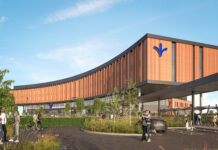
Limerick has a long association with air travel, but some might be surprised to know that the history goes way farther back than the 1945 opening of Shannon Airport. Way farther.
In the 18th century, Limerick City saw pioneering hot air balloons rise above skyline and sail into the distance.
In 1785, Richard Crosbie became the first Irish man to make a manned flight. He flew in a hydrogen air balloon across Dublin. This came just 14 months after the first-ever manned balloon flight by the Montgolfier Brothers in France. Just over a year later, on April 27, 1786, Crosbie ascended in a balloon from Clancy Strand and travelled to the area that is now Shannon Airport.
The Wright brothers carried out their inaugural flight in December 1903. It would take a few more years from this pioneering flight for the first practical aeroplane to be produced.
These crafts were quickly seen as advantageous by the army. In April 1912, the Royal Flying Corp (RFC) was created, with a base in Montrose, England. Engineering-minded soldiers transferred to this new regiment almost immediately.
Lieutenant Desmond Leahy Arthur, born in Clare but a member of the famous Limerick family and living in The Crescent prior to enlisting in the army, heard the call.
Arthur’s time in the skies was not long, in May 1913 he became the first causality in Montrose. He was at a height of 2,000 feet when the wing of the biplane he was piloting suddenly collapsed, plummeting to the earth. Arthur was killed instantly on impact and was not to participate in the first overseas deployment of the RFC, which left Montrose for his home town of Limerick via Scotland.
In the early evening of September 1, 1913, four army biplanes touched down in a field in Rathbane belonging to a Mr M Sheahan. The field was approximately 40 acres in size and a little uneven in parts, but was marked out with red flags to alert the pilots.
The flight commander for this convoy was Captain Charles Longcroft. At the time, Longcroft was the world record holder for a non-stop flight. His flight from Montrose to Farnborough covered the 630 miles in seven and a half hours. He had only received his Royal Aero Club certificate a year earlier.
The aircraft that arrived in Limerick belonged to the Second Squadron of the RFC. Three BE2 aircraft passed over Keeper Hill as they journeyed to the city, much to the delight of the thousands of spectators who gathered along the route.
While one of the machines flew directly to the landing field, two detoured towards the city, steering past St Mary’s Cathedral on their way to Rathbane.
The BE2 was a British single-engine tractor two-seat biplane designed by Geoffrey de Havilland and E T Busk and developed at the Royal Aircraft Factory.
Although delayed, a fourth aircraft, a Maurice Farman, piloted by Captain George William Patrick Dawes, arrived in Limerick from Montrose via Stranraer. This aircraft had a maximum speed of 50 miles per hour. Once landed, all the aircrafts were ushered towards the hangers erected days earlier in Sheahan’s field.
The Limerick photographer Franz Haselbeck was on the scene to photograph the momentous moment. He captured an image of Longcroft in the cockpit of his aircraft just after landing. As the machines were being attended to by mechanics, the squadron travelled into the city to dine and rest in Cruise’s Hotel.
The following day, after rest and repairs, all four of these wondrous machines took to the sky again. The take-off was observed by thousands of locals who stood in awe as the aircrafts each travel on the ground for about 70 yards before ascending and circling the skies around Limerick several times.
Over the following few days, more aircraft arrived in Rathbane. Several flights were made to the surrounding countryside, carrying out manoeuvres to mimic warfare over the county. This caused much excitement in rural villages.
The scene in Oola was described in the Clonmel National: “Suring the morning the village has been agog with excitement and bustle … Yet, amid all this terrible state of siege, you never saw a more jocose, easy-going, happy-go-lucky crowd of villagers! Just about 11 o’clock a loud noise is heard, “An aeroplane!” The shout goes up from a hundred throats. Looking aloft, the spectators behold a huge crane sailing majestically along, with wings outstretched. The whirring sound was that of a motor car hurrying along the road, and a great burst of laughter goes up as the mistake is realised.”
Eventually, an actual aircraft made its way to Oola after passing over Cappamore and Doon. Other flights were taken out as far as Rathkeale and Newcastle West – the latter being the home of Limerick’s own famous aviator, Lady Heath, who took to the skies later in the 1920s.
There were three notable machine failures while the aircraft were stationed in Limerick.
On 8 September, while leaving the base heading towards Cappamore, one of the biplanes developed engine trouble over Ballysimon. The pilot, Lieutenant Waldron, dropped into a field to find the engine was badly damaged. Word was sent back to Rathbane and a new engine was quickly fitted to the aircraft as it sat in the field. It continued on its journey soon afterwards.
Another emergency landing was carried into another field, the property of M J Gleeson, Brosna, County Birr. The aircraft was damaged after it landed in a hole but continued to move into a ditch, while the pilot remained uninjured. The aircraft was dismantled and returned to Limerick.
A final accident, the most damaging of the three, happened to Longcroft himself as the pilot was travelling to the Curragh. Although he was not badly injured, the aircraft sustained a great deal of damage.
The weather also impacted the pilots’ ability to fly. Two weeks into the RFC stay in Limerick, a cold and bitter breeze swept the country. This coincided with torrential rain which prevented the aircraft from being taken out of the hangers.
After three weeks in Limerick, the aircraft departed from the area, returning to Montrose. Little did they realise that the manoeuvres practiced in and around the county would be put to the test less than a year later with the start of the First World War, a war that saw an exponential increase in the use of aircraft.
The visitation of these aircraft to the area could have inspired Limerick-born First World War ace pilots David Mary Tidmarsh (1892-1944) and John Cowell (1889-1918) to join the RFC. Cowell was killed when his aircraft, a Bristol Fighter, was shot down during an air fight.
While not a pilot, another county Limerick man, Edward Hartigan, was also killed in action in 1917 while acting as a lookout on a war plane. Interestingly, in 1915, Tidmarsh gained his Royal Aero Club Aviator’s Certificate on a Maurice Farman biplane, a plane type that was seen in Limerick less than two years earlier.
For further reading on Limerick’s pioneering aviators see:
Lindie Naughton, Lady Icarus – The Life of Irish Aviator Lady Mary Heath.










